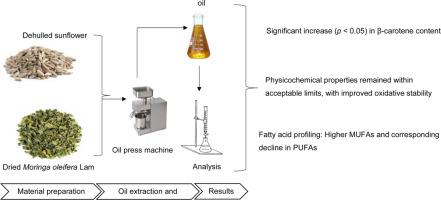Moringa-enriched sunflower oil: A novel approach to enhancing nutritional quality and oxidative stability
引用次数: 0
Abstract
Sunflower oil extraction typically involves mechanical pressing and refining, which degrades essential nutrients such as tocopherols and carotenoids. This study explores the use of dried Moringa oleifera Lam leaves as a pressing aid to enhance yield, nutritional value, and oxidative stability. Dehulled sunflower seeds were blended with Moringa oleifera Lam leaves at varying ratios (97:03, 95:05, 92:08, 86:14, 78:22, and 70:30 (w/w) before mechanical pressing to obtain oil samples (MSO1−MSO6). Results showed that dehulling improved oil quality and reduced pressing efficiency due to lower fibre content. Nutritional analysis revealed a significant increase (p < 0.05) in β-carotene content, raising from 28.69 ± 0.01 mg/kg in MSO1 to 30.47 ± 0.16 mg/kg in MSO6, whereas α-tocopherol concentration decreased with increasing Moringa oleifera Lam proportions. Fatty acid profiling indicated an increase in monounsaturated fatty acids (MUFAs) accompanied by a corresponding decrease in polyunsaturated fatty acids (PUFAs) across all samples. Physicochemical properties, including peroxide, iodine, and acid values, remained within acceptable limits, with oxidative stability improving across the formulations. These findings indicate that incorporating Moringa oleifera Lam leaves during pressing enhances both the nutritional value and functional properties of sunflower oil. The study highlights the potential of Moringa oleifera Lam-enriched sunflower oil as a functional food ingredient, offering improved stability and nutrient retention.

富含辣木的葵花籽油:一种提高营养品质和氧化稳定性的新方法
葵花籽油的提取通常涉及机械压榨和精炼,这会降低生育酚和类胡萝卜素等必需营养素。本研究探讨了使用辣木干叶作为压榨剂来提高产量、营养价值和氧化稳定性。将去壳的葵花籽与辣木叶按不同比例(97:03、95:05、92:08、86:14、78:22和70:30 (w/w)混合,然后进行机械压榨,得到油样(MSO1−MSO6)。结果表明,脱壳改善了油品质量,但由于纤维含量降低而降低了压榨效率。营养分析显示,随着辣木添加量的增加,β-胡萝卜素含量显著增加(p < 0.05),从MSO1的28.69±0.01 mg/kg增加到MSO6的30.47±0.16 mg/kg,而α-生育酚含量则下降。脂肪酸分析表明,在所有样品中,单不饱和脂肪酸(MUFAs)的增加伴随着多不饱和脂肪酸(PUFAs)的相应减少。物理化学性质,包括过氧化物、碘和酸值,保持在可接受的范围内,整个配方的氧化稳定性得到改善。上述结果表明,在压榨过程中加入辣木叶可以提高葵花籽油的营养价值和功能特性。该研究强调了辣木油籽油作为一种功能性食品成分的潜力,提供了更好的稳定性和营养保留。
本文章由计算机程序翻译,如有差异,请以英文原文为准。
求助全文
约1分钟内获得全文
求助全文
来源期刊

Food chemistry advances
Analytical Chemistry, Organic Chemistry, Chemistry (General), Molecular Biology
CiteScore
1.90
自引率
0.00%
发文量
0
审稿时长
99 days
 求助内容:
求助内容: 应助结果提醒方式:
应助结果提醒方式:


